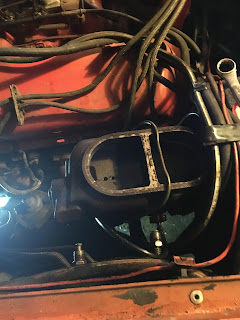With the car running well, the last piece of the puzzle was getting the brakes to work. In preparation for bleeding the brakes, I filled the master cylinder and didn't think to much about it. A bit of time passed before I had time to start bleeding the brakes but after getting a bench bleed kit and a self bleeder kit, I was ready to start. I popped the master cylinder top and was surprised to find the back compartment of the dual reservoir cylinder bone dry. Where did the fluid go?
 |
| Master Cylinder after clean up |
I talked with my father a bit about the issue as he was the original owner. In talking, he mentioned that he had an issue with the master cylinder but it had been so long ago he couldn't remember what the issue was. He did say that he had to fill it with brake fluid periodically. With that information in tow, I headed over to
Zip-Corvette to get a rebuild kit. This is where the fun starts but does not end. The kit arrived ahead of my brother in law coming to help me out with the car for a couple of days.
 |
| Master Cylinder Piston Cleaning |
The issue at hand was that the brake pedal was hard as a rock and would not depress. Prior to purchasing he rebuild kit, it appeared that there was no power booster which would indicate standard brakes. I ordered the standard rebuild kit. Once we pulled the master cylinder and we were able to remove the pistons, we quickly realized that the piston on the rebuild kit was too small. I called
Zip-Corvette to talk it through. I measured the piston bore on what we pulled out and it measured 1 1/8 inch which is the size of the power brake piston bore. In an attempt to get the car on the road, we opted to clean up the existing parts, clean out the master cylinder piston sleeve and reservoir and put it back together. In order to get the pistons out, we removed the retaining clip and tried blowing the piston out with an air compressor. This did not work at all. We ended up using a hammer and a piece of round pipe to knock the piston spring loose and we were then able to remove the first piston. The second piston was able to be blown out with an air compressor which worked great. Using a small wire brush and a ton of brake fluid, the pistons and cylinder were soaked and scrubbed to get all the residue out. Once it was cleaned up we were able to put it back together and and put back in the car. The brake pedal now behaved correctly and went to the floor as I would have expected. It was time to move on to bleeding the brakes. The brake bleeding was not successful, we were able to get some fluid out of the back brakes but nothing from the front brakes. This prompted the checking of the caliper pistons, proportioning valve and the brake lines. In the next post I will provide details on what was found.




Comments
Post a Comment